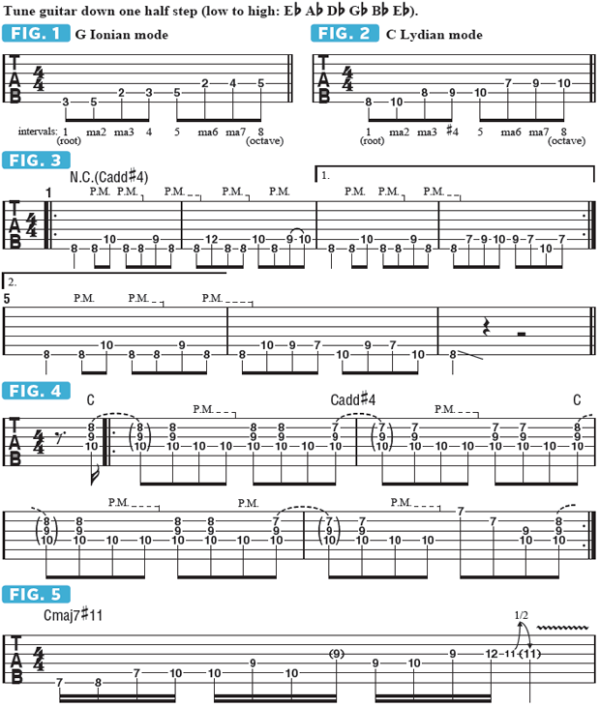How to Build Heavy Riffs and Unusual Chords From the Modes
Use the fundamental modes to discover new chord shapes and melodic ideas.
One of my favorite ways to explore new riffs, chord patterns and melodic figures is to take one of the seven fundamental modes and use its structure as a guideline.
In doing so, I often discover new chord shapes or melodic ideas that I may not have otherwise come across.
Using this modal approach also offers a systematic way to take existing riffs or chordal ideas and tweak them in new and different harmonic directions.
The seven fundamental modes are built from the major scale, also known as the Ionian mode, which is spelled, intervallically, one (the root), major second, major third, perfect fourth, perfect fifth, major sixth, major seventh. Starting on each successive note, or degree, of the major scale and ascending one octave through that same set of notes forms a different, unique mode.
As a kid, I found this very confusing.I thought, If all of these modes are made up of the same seven notes, what makes each of them different from one another? What I discovered is that one has to think of each starting note as the new root note, or tonal center, which reorients the intervallic structure of the other notes around it and establishes the formation of the “root chord” of each mode.
As an example, let’s look at the G major scale, illustrated in FIGURE 1. The notes of G major are G A B C D E F#, and, intervallically, the sequence is 1 (root), ma2, ma3, 4, 5 ma6, ma7, 8 (octave). The next mode—the second mode—is found by starting on the second degree of the scale, A, and playing through the same series of notes up to A, one octave higher; this forms the A Dorian mode: A B C D E F# G, intervallically spelled 1 (root), ma2, b3, 4, 5, ma6, b7, relative to the root note A.
If we move up to the fourth note of the G major scale, C, and do the same thing, we get what’s called the C Lydian mode, illustrated in FIGURE 2. The note pattern is C D E F# G A B, and, if we think of C as the new root, this note sequence is intervallically spelled 1 (root) ma2, ma3, #4 (sharp four), 5, ma6, ma7. As it is built from the fourth degree of the G major scale, C Lydian is considered that scale’s fourth mode.
The only difference, structurally, or intervallically, between Ionian and Lydian, is the fourth scale degree: in Ionian, it is a perfect fourth; in Lydian, it is augmented, or “sharp-ed.” The #4 (in this case F#) is the characteristic interval that distinguishes the Lydian mode from its Ionian counterpart, which in this case would be C Ionian: C D E F G A B.
FIGURE 3 is a single-note riff designed to emphasize the Lydian mode’s augmented fourth. Bouncing off a low C root note, I play a melodic line on the A string centered around F#, highlighting that note as the riff’s “signature” note.
FIGURE 4 applies this same concept to a chordal idea, as I strum a syncopated pattern that shifts from C major triads to Cadd#4 shapes by simply moving the note G (B string, eighth fret) down one fret, to F#. In FIGURE 5, I apply this concept to a lead phrase. Using a C major triad (C E G) in three octaves as a basis, I move in each octave from the fifth, G, to the augmented fourth, F#, emphasizing a Lydian modality.


Get The Pick Newsletter
All the latest guitar news, interviews, lessons, reviews, deals and more, direct to your inbox!










